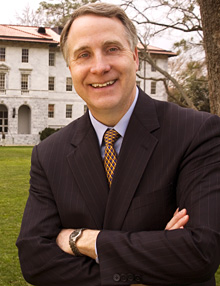Spring 2009: Letter from the President

James W. Wagner, President, Emory University
Ann Borden
Busy times in the railroad switchyard
By James W. Wagner
Maybe it’s the engineer in me: as contractions in the global economy force adjustments at Emory, a railroad image comes to mind. Emory has been cruising quite powerfully, like a freight train across the prairie, for three decades, ever since the 1979 Woodruff Gift provided an additional engine and moved Emory onto the express track. The open terrain and a far horizon have allowed the momentum of our long train of loaded cars to build impressively.
The impact of the economy on our ride, however, has been the equivalent of reducing the amount of fuel available to keep up the full head of steam we’ve become used to. And it has done so just as we are entering the steep climb of implementing our strategic plan—in effect, when prairie turns to mountain and the slope begins to rise. We are on the right track; our collaborative planning of our strategy has told us so. But we have some decisions to make now about how we will get to our destination.
We can add more fuel—and Campaign Emory is intended to do just that. But, although the campaign can help in the near term to replace some of the pulling power we’ve lost, it is intended more importantly to provide extra fuel for our longer-term excellence. So more realistically, during the next three years we will have to reduce our load strategically. We will need to pull into the switchyard to off-load some cars and reshuffle the train, before getting up a head of steam again, restoring or exceeding our past momentum with less fuel.
The current prospect of a long period of diminished resources requires us to think hard about what Emory will be able to pull during the next twenty-five years, because that vision will directly affect our decisions about spending in the next three years. Providence, or fate, or whatever we want to call the set of circumstances that has led us to this point, seems to have decreed a period of major change at Emory and for much of higher education, not incremental change.
How will we implement this change? How will we decide which cars—however fully loaded with good stuff—are not required at Emory’s future destination and perhaps better left to be pulled by other universities running along other tracks?
Two principles will be critically important. First, to the extent possible, our choices should leave Emory with only those activities that are excellent or essential, or should take advantage of opportunities for Emory to lead higher education. Second, identifying where we should invest and where we should cut will require broad, thorough, and open discussion and ownership throughout the University.
Determining our priorities will require answering some key questions during the next few months:
- Where are we headed?
- What activities must we do? (What is essential?)
- What do we do best today? (What is excellent?)
- At what are we least successful, to what are we less well suited?
- What must be strengthened?
- What can be eliminated?
- What opportunities for leadership do we see?
- Are the schools and units organized appropriately for what we imagine the future to be?
- Do any potential changes in schools or units compromise the University’s excellence?
The conversations that we must have around these questions should result in a clearer picture of what the schools and colleges of Emory will look like in the future. Will they be more interdisciplinary than currently? How will they get to that future state? What can our thinking contribute to the strengthening of American higher education generally? How can a stronger and more “Emory-like” Emory serve as a model for our peers?
In the coming months the leadership at Emory—deans and cabinet officers but also faculty leaders and others—will be working hard to answer these questions before the next fiscal year gets under way. To revert to the train metaphor, I believe that these conversations will help Emory to reach, more essentially and excellently, the destination it set out for thirty years ago, to be a premier research university teaching, discovering, preserving, and applying knowledge in the service of humankind.